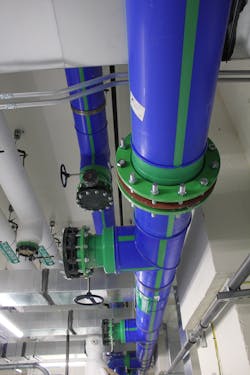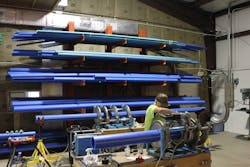Williams Plumbing Helps Hospital Reach for the (Big) Sky
BOZEMAN, MT — A frontier town of just 3,400 souls in 1900, the population of Bozeman grew steadily to 28,210 in 2000 and then boomed to 49,831 by 2019. It was the fastest growing micropolitan statistical area in the United States (as defined by the U.S. Office of Management and Budget) in both 2018 and 2019.
Long a magnet for outdoor enthusiasts, Bozeman has become a tech mecca in the age of the “digital economy.” Tourism-based industries such as hospitality and food service also thrive here, but the anchors of the local economy are Bozeman’s two largest employers: Montana State University and Bozeman Health.
Bozeman Health is comprised of two hospitals, several specialty treatment centers, a network of physician and urgent-care clinics, outpatient treatment facilities, and retirement and assisted-living facilities.
The centerpiece of Bozeman Health is Bozeman Health Hospital, a nonprofit community hospital that serves southwestern Montana. What began more than a century ago as a 20-bed hospital with one doctor is now an 88-bed facility with nearly 200 physicians on staff representing 42 specialties.
As Bozeman has grown over the past 100-plus years, Bozeman Health Hospital has grown along with it. So when it came time to grow again—this time with a three-story intensive care unit addition—Bozeman Health turned to their long-time partners Williams Plumbing for the mechanical systems work.
Comprehensive Solutions
“We will provide prompt, courteous service, complete your projects on time, and our experienced team will meet or exceed your standards for quality,” the company promises.
When contacted by Bozeman Health about the installation of a piping system for the new ICU tower at Bozeman Health Hospital, General Superintendent Tom Harmon and the rest of the Williams Plumbing team were ready.
The ICU tower’s chiller-based system was originally spec’d for carbon steel pipe for the hydronic heating and cooling system water, chilled water, and condenser water, as well as some domestic water.
However, the project’s engineering firm, Cushing Terrell, provided engineering recommendations to Bozeman Health regarding other materials to reduce overall construction cost. These recommendations included changing the spec for the chilled and domestic water to Aquatherm pipe. As experienced Aquatherm installers, Harmon and his crew were very pleased. They were well-aware of Aquatherm’s advantages over steel, including its lighter weight and ability to be custom-fabricated on- or off-site. In addition, Aquatherm installations can require less manpower than carbon steel installations, contributing to what is often a lower total installed cost than steel.
Although Cushing Terrell initially designed around steel pipe, specifically in the chiller mechanical room where larger pipes (12-in. and 14-in.) were directly connected to the evaporator and condenser chiller bundles, Aquatherm piping presented a viable alternate.
“I’ve worked on several large Aquatherm projects over the last six years, both at the hospital and at Montana State University, and I can tell you that using steel would probably have doubled the time and manpower required on this project,” Harmon said.
The System Takes Shape
The piping project at Bozeman Hospital consists of roughly one mile of Aquatherm Blue Pipe® and Aquatherm Green Pipe® ranging in size from one-half in. to 14-in. Other equipment includes two 30-hp Taco pumps, two 400-ton York chillers, and two Marley cooling towers for the hydronic side, and Taco pumps and Lochinvar water heaters for the domestic side. With two chillers operating, maximum flow at the pumps on the chilled water plant is 1,740 gpm at the evaporator and 2,020 gpm at the condenser.
The chilled-water system operates at 53°F entering-water temperature / 42°F leaving-water temperature. It provides the primary source of cooling for the air handlers in the ICU tower, as well as the hospital’s operating rooms, which require low supply-air temperatures. The chiller’s condenser water is designed to run at 85°F EWT / 75°F LWT based on outside air temperature.
“The cooling towers are used to cool the chiller compressor only,” Harmon explained. “The condenser water pulls the heat off the compressor to keep the compressor cold. But it doesn’t need to be cold water.”
In addition, the York magnetic-bearing chiller can operate as an integrated flat-plate heat exchanger to provide free cooling during shoulder months when refrigerant cooling is not required.
Harmon noted that, as with any piping system, careful system design and proper operation are keys to help ensure successful outcomes and trouble-free performance for the end-user.
“Proper planning and design are always among our biggest priorities on any project,” he said, adding: “We have not experienced any issues with Aquatherm, even in domestic hot water installations.”
Clean and Flame-Free
Williams Plumbing has about 75 Aquatherm-trained installers. On this project the installation team used McElroy and Widos fusion equipment. The clean, heat-fusion connections represent an added benefit of using Aquatherm pipe in a hospital project.
“Because this was originally a carbon steel job, we were going to have to deal with hot-work permits and welding smoke mitigation,” Harmon said. “With Aquatherm pipe we did not have to do any of that. There are no sparks or open flame with the fusion irons, and even when you’re cutting Aquatherm, you’re not creating sparks. In addition, we’re not using any gas, glues, or solder to join the pipes, and we’re not creating any dust or metallic shavings. From an environmental standpoint it’s just a much cleaner product than steel.”
From an end-user perspective, Aquatherm’s clean installation helps prevent operations and maintenance issues.
“Aquatherm never has the dirt and grit in it that you get when you weld steel, and it doesn’t scale like metal pipes,” Harmon said. “All most end-users have to do is periodically check the O-rings and cycling of the ball valves.”
Custom Fabrication
The ability to custom-fabricate Aquatherm on- or off-site represents another important benefit to hospital clients. Williams Plumbing has its own fabrication shop where assemblies based on projects’ 3-D BIM drawings can be prepared in advance. The custom-made assemblies can then be shipped to the job site and installed easily because their light weight.
Aquatherm provides a full library of CAD and BIM families and can also provide full fabrication from its Utah facility. This comes in handy when a contractor doesn’t have the tooling, manpower, or expertise to create spools or assemblies.
“An additional benefit of using Aquatherm is that it's very maneuverable,” Harmon said. “In a hospital everything is packed tight and you're not always able to get a welder or a torch in those little spots. With Aquatherm, we’re usually able to fabricate spools on the spot that will accommodate any space we might be dealing with, no matter how tight.”
Ultimately, growth like that being experienced in Bozeman calls for infrastructure upgrades to accommodate the growing number of residents, and a hospital expansion is certainly high on any such list.
For additional insights about Williams Plumbing and a behind-the-scenes look into their successful installations of Aquatherm pipe, check out this video: https://aquatherm.com/videos/why-williams-plumbing-chooses-aquatherm


